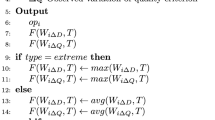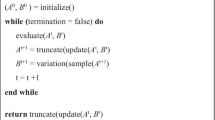Abstract
The incorporation of additional constraints to the basic mean–variance (MV) model adds realism to the model, but simultaneously makes the problem difficult to be solved with exact approaches. In this paper we address the challenges that have arisen by the multi-constrained portfolio optimization problem with the assistance of a novel specially engineered multi-objective evolutionary algorithm (MOEA). The proposed algorithm incorporates a new efficient representation scheme and specially designed mutation and recombination operators alongside with efficient algorithmic approaches for the correct incorporation of complex real-world constraints into the MV model. We test the algorithm’s performance in comparison with two well-known MOEAs by using a wide range of test problems up to 1317 stocks. For all examined cases the proposed algorithm outperforms the other two MOEAs in terms of performance and processing speed.












Similar content being viewed by others
Explore related subjects
Discover the latest articles, news and stories from top researchers in related subjects.References
Anagnostopoulos K and Mamanis G (2010). A portfolio optimization model with three objectives and discrete variables. Computers & Operations Research 37(7):1285–1297.
Babaei S, Sepehri MM and Babaei E (2015). Multi-objective portfolio optimization considering the dependence structure of asset returns, European Journal of Operational Research 244(2):525–553.
Baykasoğlu A, Yunusoglu MG and Burcin Özsoydan F (2015). A GRASP based solution approach to solve cardinality constrained portfolio optimization problems. Computers & Industrial Engineering, 90(C):339–351.
Beasley JE (1990). OR-Library: Distributing test problems by electronic mail. Journal of the Operational Research Society 41(11):1069–1072.
Bertsimas D and Shioda R (2009). Algorithm for cardinality-constrained quadratic optimization. Computational Optimization and Applications 43(1):1–22.
Bloomfield T, Leftwich R and Long J (1977). Portfolio strategies and performance. Journal of Financial Economics 5(2):201–218.
Branke J, Scheckenbach B, Stein M, Deb K and Schmeck H (2009). Portfolio optimization with an envelope-based multi-objective evolutionary algorithm. European Journal of Operational Research 199(3):684–693.
Cesarone F, Scozzari A and Tardella F (2008). Efficient algorithms for mean–variance portfolio optimization with hard real-world constraints. In: The 18th AFIR colloquium: Financial risk in a changing world, Rome.
Chang TJ, Meade N, Beasley JE and Sharaiha YM (2000). Heuristics for cardinality constrained portfolio optimisation. Computers & Operations Research 27(13):1271–1302.
Corazza M, Fasano G and Gusso R (2013). Particle swarm optimization with non-smooth penalty reformulation, for a complex portfolio selection problem, Applied Mathematics and Computation 224:611–624.
Deb K and Agrawal RB (1995). Simulated binary crossover for continuous search space. Complex Systems 9(2):115–148.
Deb K and Tiwari S (2008). Omni-optimizer: A generic evolutionary algorithm for single and multi-objective optimization. European Journal of Operational Research 185(3):1062–1087.
Evans JL and Archer SH (1968). Diversification and the reduction of dispersion: An empirical analysis. Journal of Finance 23(5):761–767.
Fisher L and Lorie JH (1970). Some studies of variability of returns on investments in common stocks. Journal of Business 43(2):99–134.
Liagkouras K and Metaxiotis K (2013). An elitist polynomial mutation operator for improved performance of MOEAs in computer networks. In: Computer communications and networks (ICCCN), 2013 22nd international conference on, pp 1–5. doi:10.1109/ICCCN.2013.6614105.
Liagkouras K and Metaxiotis K (2014). A new probe guided mutation operator and its application for solving the cardinality constrained portfolio optimization problem. Expert Systems with Applications 41(14):6274–6290.
Liagkouras K and Metaxiotis K (2015a). An experimental analysis of a new two-stage crossover operator for multiobjective optimization. Soft Computing. doi: 10.1007/s00500-015-1810-6.
Liagkouras K and Metaxiotis K (2015b). An experimental analysis of a new interval-based mutation operator. International Journal of Computational Intelligence and Applications 14(3):1550018. doi:10.1142/S1469026815500182.
Liagkouras K and Metaxiotis K (2015c). Efficient portfolio construction with the use of multiobjective evolutionary algorithms: Best practices and performance metrics. International Journal of Information Technology & Decision Making 14(3):535–564.
Liagkouras K and Metaxiotis K (2015d). Enhancing the performance of MOEAs: An experimental presentation of a new fitness guided mutation operator. Journal of Experimental & Theoretical Artificial Intelligence. doi:10.1080/0952813X.2015.1132260.
Liagkouras K and Metaxiotis K (2015e). A new probe guided mutation operator for more efficient exploration of the search space: An experimental analysis. International Journal of Operational Research 25(2):212–251.
Lwin K, Qu R and Kendall G (2014). A learning-guided multi-objective evolutionary algorithm for constrained portfolio optimization. Applied Soft Computing 24:757–772.
Markowitz H (1952). Portfolio selection. Journal of Finance 7(1):7 7–91.
Metaxiotis, K and Liagkouras K. (2012) Multiobjective evolutionary algorithms for portfolio management: A comprehensive literature review. Expert Systems with Applications 39(14):11685–11698.
Metaxiotis K and Liagkouras K (2013). A fitness guided mutation operator for improved performance of MOEAs electronics, circuits, and systems (ICECS). In: 2013 IEEE 20th international conference on, pp 751–754. doi:10.1109/ICECS.2013.6815523.
Mishra SK, Panda G and Majhi R (2014). A comparative performance assessment of a set of multiobjective algorithms for constrained portfolio assets selection. Swarm and Evolutionary Computation 16:38–51.
Mishra SK, Panda G and Majhi B (2016). Prediction based mean-variance model for constrained portfolio assets selection using multiobjective evolutionary algorithms. Swarm and Evolutionary Computation 28(2016):117–130.
Saborido R, Ruiz AB, Bermúdez JD, Vercher E and Luque M (2016). Evolutionary multi-objective optimization algorithms for fuzzy portfolio selection. Applied Soft Computing 39:48–63.
Shaw DX, Liu S and Kopman L (2008). Lagrangian relaxation procedure for cardinality-constrained portfolio optimization. Optimisation Methods & Software 23(3):411–420.
Storn R and Price K (1997). Differential evolution—A simple and efficient heuristic for global optimization over continuous spaces. Journal of Global Optimization 11(4):341–359.
Streichert F, Ulmer H and Zell A (2004a). Evaluating a hybrid encoding and three crossover operators on the constrained portfolio selection problem. In: Proceedings of the Congress on evolutionary computation (CEC 2004), Portland, pp 932–939.
Streichert F, Ulmer H and Zell A (2004a). Comparing discrete and continuous genotypes on the constrained portfolio selection problem. In: Deb K et al. (ed) Genetic and evolutionary computation—GECCO 2004. Proceedings of the genetic and evolutionary computation conference. Part II, Lecture Notes in Computer Science, vol 3103. Springer, Seattle, pp 1239–1250.
Vercher E and Bermúdez JD (2015). Portfolio optimization using a credibility mean-absolute semi-deviation model. Expert Systems with Applications 42(20):7121–7131.
Woodside-Oriakhi M, Lucas C and Beasley JE (2011). Heuristic algorithms for the cardinality constrained efficient frontier. European Journal of Operational Research 213(3):538–550.
Woodside-Oriakhi M, Lucas C and Beasley JE (2013). Portfolio rebalancing with an investment horizon and transaction costs. Omega 41(2):406–420.
Zhang Q and Li H (2007). MOEA/D: A multiobjective evolutionary algorithm based on decomposition. IEEE Transactions on Evolutionary Computation 11(6):712–731.
Zhang P and Zhang WG (2014). Multiperiod mean absolute deviation fuzzy portfolio selection model with risk control and cardinality constraints. Fuzzy Sets and Systems 255(16):74–91.
Zitzler E and Thiele L (1999). Multiobjective evolutionary algorithms: A comparative case study and the strength Pareto approach. IEEE Transactions on Evolutionary Computation 3(4):257–271.
Zitzler E, Deb K and Thiele L (2000). Comparison of multiobjective evolutionary algorithms: Empirical results. Evolutionary Computation 8(2):173–195.
Zitzler E, Thiele L, Laumanns M, Foneseca CM and Fonseca VG (2003). Performance assessment of multiobjective optimizers: An analysis and review. IEEE Transactions on Evolutionary Computation 7(2):117–132.
Author information
Authors and Affiliations
Corresponding author
Rights and permissions
About this article
Cite this article
Liagkouras, K., Metaxiotis, K. Handling the complexities of the multi-constrained portfolio optimization problem with the support of a novel MOEA. J Oper Res Soc (2017). https://doi.org/10.1057/s41274-017-0209-4
Received:
Accepted:
Published:
DOI: https://doi.org/10.1057/s41274-017-0209-4




